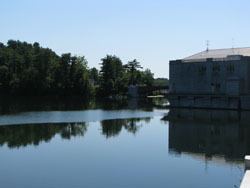Catchment area 147.6 km² | Primary inflows Basin countries United States Outflow location Croton River | |
 | ||
The New Croton reservoir is a narrow reservoir in Westchester County, New York, lying approximately 22 miles (35 km) north of New York City, for which the reservoir supplies water. It is the collecting point for water from all reservoirs in the Croton Watershed.
Contents
Map of New Croton Reservoir, New York, USA
HistoryEdit
The original reservoir was called Croton Lake, and was New York City's first source of water not located in the city itself. The reservoir was created in 1842 by damming the Croton River, a tributary of the Hudson River. Around the turn of the 20th century, the City of New York enlarged the reservoir by constructing the New Croton Dam to supply the city with more water. The new enlarged reservoir, completed in 1905, is one of the bigger of the small reservoirs, and is the largest reservoir in the Croton Watershed. It is approximately 9 miles (14 km) long, and it can hold 19 billion US gallons (72,000,000 m3) of water at full capacity. A small part of its water comes from rain on its own drainage basin that covers 57 square miles (148 km²) of land.
The drinking water from the reservoir flows into the New Croton aqueduct while about three-quarters of the way through the reservoir. From there it goes to the city, and enters the Jerome Park Reservoir in The Bronx. It then continues to flow through the rest of the city until the water from the New Croton Aqueduct mixes with water from the Catskill aqueduct in Manhattan. It finally continues through the NYC boroughs of Brooklyn and Staten Island, which are the termini of the distribution system.
